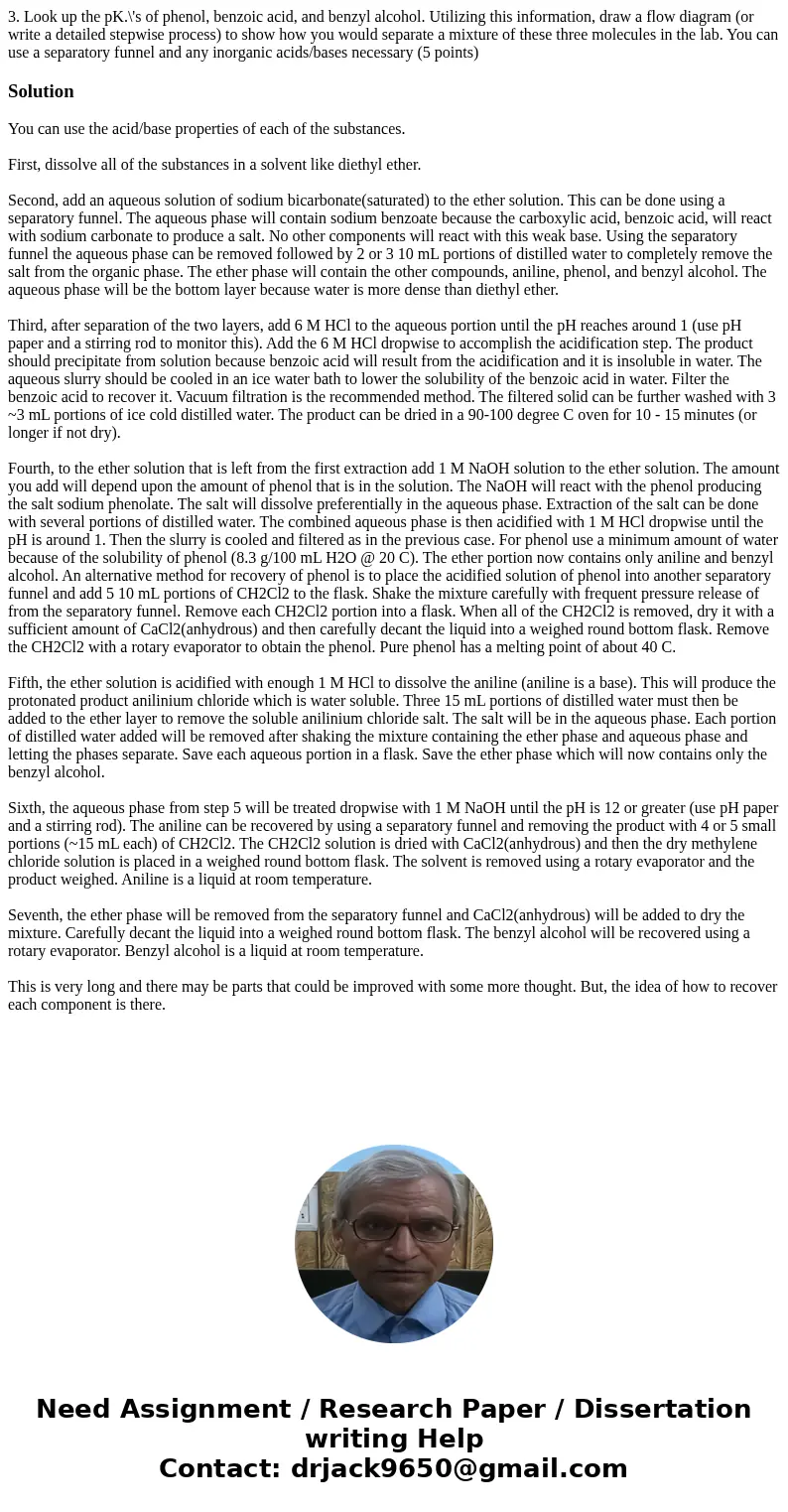3 Look up the pKs of phenol benzoic acid and benzyl alcohol
Solution
You can use the acid/base properties of each of the substances.
First, dissolve all of the substances in a solvent like diethyl ether.
Second, add an aqueous solution of sodium bicarbonate(saturated) to the ether solution. This can be done using a separatory funnel. The aqueous phase will contain sodium benzoate because the carboxylic acid, benzoic acid, will react with sodium carbonate to produce a salt. No other components will react with this weak base. Using the separatory funnel the aqueous phase can be removed followed by 2 or 3 10 mL portions of distilled water to completely remove the salt from the organic phase. The ether phase will contain the other compounds, aniline, phenol, and benzyl alcohol. The aqueous phase will be the bottom layer because water is more dense than diethyl ether.
Third, after separation of the two layers, add 6 M HCl to the aqueous portion until the pH reaches around 1 (use pH paper and a stirring rod to monitor this). Add the 6 M HCl dropwise to accomplish the acidification step. The product should precipitate from solution because benzoic acid will result from the acidification and it is insoluble in water. The aqueous slurry should be cooled in an ice water bath to lower the solubility of the benzoic acid in water. Filter the benzoic acid to recover it. Vacuum filtration is the recommended method. The filtered solid can be further washed with 3 ~3 mL portions of ice cold distilled water. The product can be dried in a 90-100 degree C oven for 10 - 15 minutes (or longer if not dry).
Fourth, to the ether solution that is left from the first extraction add 1 M NaOH solution to the ether solution. The amount you add will depend upon the amount of phenol that is in the solution. The NaOH will react with the phenol producing the salt sodium phenolate. The salt will dissolve preferentially in the aqueous phase. Extraction of the salt can be done with several portions of distilled water. The combined aqueous phase is then acidified with 1 M HCl dropwise until the pH is around 1. Then the slurry is cooled and filtered as in the previous case. For phenol use a minimum amount of water because of the solubility of phenol (8.3 g/100 mL H2O @ 20 C). The ether portion now contains only aniline and benzyl alcohol. An alternative method for recovery of phenol is to place the acidified solution of phenol into another separatory funnel and add 5 10 mL portions of CH2Cl2 to the flask. Shake the mixture carefully with frequent pressure release of from the separatory funnel. Remove each CH2Cl2 portion into a flask. When all of the CH2Cl2 is removed, dry it with a sufficient amount of CaCl2(anhydrous) and then carefully decant the liquid into a weighed round bottom flask. Remove the CH2Cl2 with a rotary evaporator to obtain the phenol. Pure phenol has a melting point of about 40 C.
Fifth, the ether solution is acidified with enough 1 M HCl to dissolve the aniline (aniline is a base). This will produce the protonated product anilinium chloride which is water soluble. Three 15 mL portions of distilled water must then be added to the ether layer to remove the soluble anilinium chloride salt. The salt will be in the aqueous phase. Each portion of distilled water added will be removed after shaking the mixture containing the ether phase and aqueous phase and letting the phases separate. Save each aqueous portion in a flask. Save the ether phase which will now contains only the benzyl alcohol.
Sixth, the aqueous phase from step 5 will be treated dropwise with 1 M NaOH until the pH is 12 or greater (use pH paper and a stirring rod). The aniline can be recovered by using a separatory funnel and removing the product with 4 or 5 small portions (~15 mL each) of CH2Cl2. The CH2Cl2 solution is dried with CaCl2(anhydrous) and then the dry methylene chloride solution is placed in a weighed round bottom flask. The solvent is removed using a rotary evaporator and the product weighed. Aniline is a liquid at room temperature.
Seventh, the ether phase will be removed from the separatory funnel and CaCl2(anhydrous) will be added to dry the mixture. Carefully decant the liquid into a weighed round bottom flask. The benzyl alcohol will be recovered using a rotary evaporator. Benzyl alcohol is a liquid at room temperature.
This is very long and there may be parts that could be improved with some more thought. But, the idea of how to recover each component is there.

 Homework Sourse
Homework Sourse